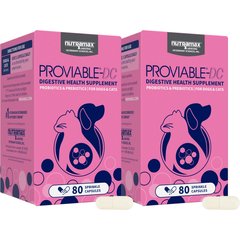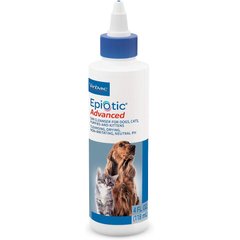Thiamine Deficiency in Dogs More Common Than You Realize
Today over on Nutrition Nuggets for Cats, we started a discussion on the unexpected (to me at least) prevalence of thiamine deficiency in dogs and cats. If you haven’t already taken a look at that post, start there before reading further.
You’re back? Good.
Thiamine deficiency can develop for a number of reasons. Intestinal disease can reduce the ability of the body to absorb thiamine, and the administration of some medications (e.g., diuretics) can also reduce levels of thiamine in the body. Dogs and cats who eat home prepared diets are at higher than average risk if these recipes don’t contain adequate amounts (a particular problem for those made from raw fish or shellfish due to the presence of an enzyme that destroys thiamine), but in contrast to what is seen with most other nutritional deficiencies, problems with thiamine pop up in commercially prepared foods with some regularity as well.
Recommended Pet Products
- Nutramax Proviable Probiotics & Prebiotics Digestive Health Supplement for Dogs & Cats, 160 count$89.98Chewy Price
- Fera Pets USDA Organic Pumpkin Plus Fiber Support for Dogs & Cats, 90 servings$34.95Chewy Price
- All Four Paws Comfy Cone E-Collar for Dogs & Cats, Black, Small$20.24Chewy Price
- Virbac Epi-Otic Advanced Ear Cleaner for Dogs & Cats, 4-fl oz bottle$12.77Chewy Price
According to an article appearing in the September, 1 2013 edition of the Journal of the American Veterinary Medical Association (JAVMA):
Although dry foods can be deficient in thiamine, it is more common in canned foods for a number of reasons. Canned food production is a multistep process that involves grinding and mixing of the food, filling and sealing of the cans, and sterilizing the food within the cans. The sterilization (retort) step is important for destroying common pathogenic bacteria. However, thiamine is a heat-labile vitamin, and losses of > 50% of the thiamine content have been considered to be a result of processing. In addition, some canned diets include alkalinizing gelling agents that can alter the pH and therefore the availability of thiamine. Manufacturers should consider all of these factors, use analytic methods to estimate the amount of thiamine lost to processing or inactivated because of pH, and supplement the diet with additional sources of thiamine prior to the sterilization process to compensate for impending losses. In addition, reputable manufacturers will analyze the final diet to determine the content of thiamine and other nutrients to ensure that they meet minimum values.
The duration and environmental conditions associated with storage of a commercial cat or dog food after manufacturing can further affect the amount of vitamin loss over time. Although B vitamins are not as susceptible to loss during storage as are fat-soluble vitamins, thiamine is one of the B vitamins most susceptible to loss during storage... It has been suggested that thiamine losses can be as great as 57% in dry dog food and 34% in dry cat food after 18 months of storage; however, the loss of thiamine appears to be minimal in canned food.
The symptoms of thiamine deficiency are somewhat vague and nonspecific. As the JAVMA article describes:
Three progressive stages associated with thiamine deficiency have been described: induction, critical, and terminal. As described in a controlled study and a retrospective report, the induction stage generally develops within 1 week after animals begin eating a diet severely deficient in thiamine and is characterized by hyporexia [poor appetite], vomiting, or both [neurologic and cardiac dysfunction develop as the condition progresses]. Typically, an animal must be thiamine deficient for slightly more than 1 month before the terminal stage is reached. However, once the terminal stage has started, an animal will die within a few days if the deficiency is not corrected immediately... Typically, it can take weeks to months for the development of clinical signs, which are attributable to subchronic deficiency because most diets are not entirely devoid of thiamine. Mitigating factors include the amount of thiamine in the food, nutrient composition of the diet, whether the animal eats a consistent diet, and species and health status of the animal.
Diagnosing thiamine deficiency in a dog or cat is not as straightforward as you might think. Several different tests are available but none are diagnostic in all cases. Also, the veterinarian has to have thiamine deficiency on his or her radar screen to think to send samples to the lab for testing. Alternatively, characteristic abnormalities can be picked up on an MRI, which might be ordered because of a pet’s neurologic symptoms. Since most cases of thiamine deficiency are diagnosed when the condition is quite advanced and life threatening, a veterinarian may elect to begin treatment before a definitive diagnosis is reached.
Thankfully, treatment for thiamine deficiency is not complicated. The patient is given injections of thiamine for three to five days followed by oral supplementation for another two to three weeks. Of course whenever possible, correcting the cause of the pet’s thiamine deficiency (e.g., an imbalanced diet, gastrointestinal disease, or medication administration) is important to their recovery as well.

Dr. Jennifer Coates
Reference
Thiamine deficiency in dogs and cats. Markovich JE, Heinze CR, Freeman LM. J Am Vet Med Assoc. 2013 Sep 1;243(5):649-56.
Image: urbans / Shutterstock




